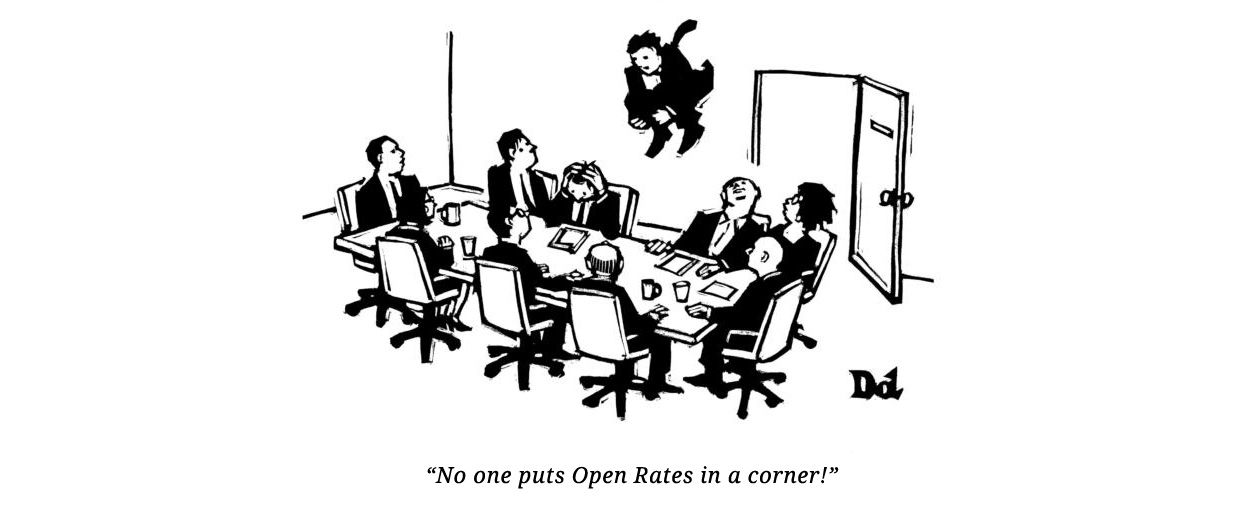The Great Open Rate Debate
Oh, the mysterious and sometimes illusive golden metric in email marketing: the open rate. On the surface, it’s a pretty simple concept: how many people open the emails you send them. Depending on the goal of your email campaign, this metric can be more or less meaningful, but it’s ALWAYS high in the mind for email marketers, especially those of us in the nonprofit world who compete for eyeballs, often with limited resources. While there are several factors that influence one’s decision to open an email (including the from line and pretext, not to mention technical details like proper segmentation and list hygiene practices that land your message with the correct people), we’re going to focus here on the subject line –- that proverbial cover to the book we’re judging whether or not to open. Not only is it influential… but it is controversial!

There’s a history of debate and philosophizing on the efficacy of open rates as a Key Performance Indicator (KPI) for email campaigns going way back to at least 2004, when our pioneering ancestors were bravely sailing the uncharted seas of Gmail and Outlook, navigating the relatively new territory of email marketing. So what’s the great Open Rate Debate all about? The dispute goes something like this: how effective can open rates really be, when all they tell us is whether someone looked at your message or not? After all, you can conceivably have an atypically high open rate (using a stunt subject line, for example) and still have zero conversions, especially if constituents feel tricked.
However, “the other camp” points out that you will never have conversions if readers aren’t even making it past the subject line –- you can’t click to take an action if you’re so turned off or bored by a subject line that you don’t bother to open. To reframe the argument, one side suggests altogether abandoning open rates as a useful engagement metric while the other side posits open rates as the determinate factor in an email’s success. To that, we diplomatically say: both sides are wrong and both sides are right. Email open rates can only tell you so much about the success of a campaign. If impressions and reach are the goal of a campaign –- to raise awareness about an issue or as a save-the-date for a fundraising gala –- then it makes sense to prioritize open rates as the most important metric.
However, if your goal is conversions, open rates may take a back seat to other factors such as click rate and/or conversions. In fact, you may want to target higher level donors and use subject line strategies that wouldn’t make as much sense if optimized for open rates. A simple example is to think of an annual report you’d really like board members and major donors to download. For those audiences, it may behoove you to use a very specific, somewhat boring, descriptive subject line like “Annual Report to Download.” This runs counter to the conventional logic of using a more vague subject line on larger audiences (prospects, for example), when you’re trying to hook as many people as possible, hoping that they’ll make it far enough to download that report. In the former example, you would likely have a lower open rate, but higher conversion rate (if conversions = downloading the report), while in the latter, you’d likely get a higher open rate with lower conversions.
Where does this leave an intrepid email fundraiser navigating these choppy waters? A few key takeaways from all this:
-
Open rates are just one metric that give us limited data on one aspect of an email’s performance.
-
Open rates, as a KPI, should be judged depending on the goals of the campaign: if conversions are your game, they’re just the first factor in leading constituents to take action. If awareness is your goal, open rates may be weighted as more important.
-
Don’t trick your audience –- a boost in open rates due to a misleading or stunt subject line is probably not worth a boost in unsubscribe rates (let alone the danger of triggering spam filters). If someone opts out, they’re gone forever. If someone doesn’t open your email, they still may next round.
-
TEST, TEST, TEST! Have your goal in mind (conversions, opens, clicks, etc.) and then form a hypothesis: “I think major donors will respond well to straightforward subject lines, which will boost conversions.” Also, try different subject line strategies with different audiences, again depending on your goals. You’ll never know if something works unless you test it. And then test it again. And again.
-
Some subject line tests to consider: longer vs shorter subject lines, descriptive vs vague, emoji in the subject line vs no emoji, personalization vs general, directives (like FOR REVIEW) vs statements, statements vs questions, etc.
Finally, take the broad view and consider all your data together, depending on the goals of your campaign or program. It can be difficult to calibrate your colleagues’ expectations about lower than standard open rates if you’re willing to sacrifice them to conversions (as in the examples above), but a more holistic approach that considers open rates as just the first factor in determining success, and not THE factor, can lead to a more engaged and trusting audience overall –- and on the high seas of email marketing for nonprofits, a rising tide really does lift all boats (and with any luck and a lot of testing, all metrics, too!).
